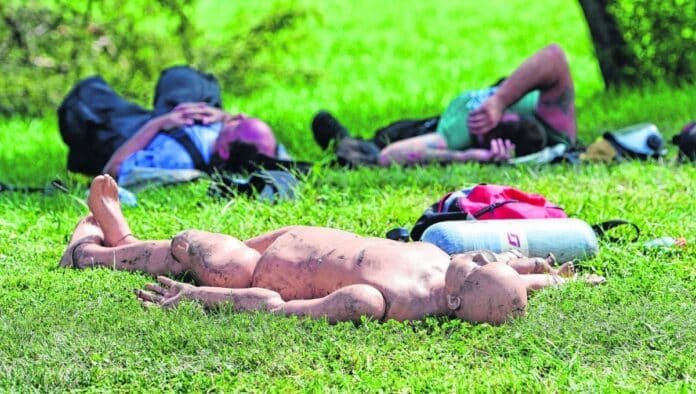
GREENFIELD — Sitting in a patch of grass about 20 feet from the back of the abandoned house, two firefighters were trying to catch their breath.
Steve Kropacek, Greenfield Fire Territory’s fire investigator; and Chris Faust, the department’s division chief of training, had been inside the empty structure for a couple of hours dressed in full gear and repeatedly setting fires. A series of fire crews had then gone through the rooms, navigating through extreme heat and smoke in a simulation that was as close to the real thing as could be.
“It’s hard work that takes a lot out of you if you’ve been in there awhile,” Faust said, with sweat dripping from his forehead.
[sc:text-divider text-divider-title=”Story continues below gallery” ]
Click here to purchase photos from this galleryThe training took place on Saturday, Sept. 12, at a former home in the 800 block of West County Road 100S. The structure was donated by Gary Edwards, a friend of the department, to help local firefighters get specialized training. This training event came with a twist: Leaders of the fire territory invited Greenfield City Council members and county officials to not only observe, but to take part in the burn.
The idea was to show government leaders just what firefighters actually do when they enter a burning building.
Councilmen John Jester, Gary McDaniel and George Plisinski dressed in fire safety gear and went inside the burning house. Councilmen Jeff Lowder and Kerry Grass — a career fighterfighter — came to observe.
McDaniel, who had never undergone such training, noted how the fire inside was relatively small but produced an intense heat.
“As someone who has never done anything like this before, this was a pretty awesome learning experience,” McDaniel said. “We need to know how these guys work because they do something not everyone wants to do.”
Keely Butrum, a former city councilwoman who will join the county council in January, is interested in learning more about firefighting funding across the county. She went inside as well.
“These guys have to rely on their training and instincts to make really important split-second decisions, and we need to support that — find a right balance of funds distribution,” Butrum said.
Jester, whose father served as chief of the Greenfield Fire Department and who has worked as a firefighter himself, said he was thrilled to get a chance to go inside for a burn again.
“For a training session, it can’t get any better than this,” said Jester, whose son is a firefighter. “For the new guys to get in there and feel that heat, it’s the one thing I do not miss.”
Jester, like Butrum, noted the importance of making sure firefighters get proper training while being paid well enough to stay in the county. Turnover has been a concern lately.
“It’s good for the council members to see these guys need help and we’re listening,” Jester said.
Officials from the department spent about 120 hours getting the house prepared for the burn so they could set several fires.
“We set it up so we could get two to three burns for each room in the house,” public information officer Corey Breese said. “That gives us about 12 to 15 burns throughout the day before we burn it down.”
They also did some victim removal and rescues as well with Green Township supplying tanker support.
David Wickard, the fire territory’s union president, noted the importance of having council members present to see firsthand the work firefighters do day in and day out.
“It takes resources, financial, personnel and equipment to do our jobs,” Wickard said.
The training experience, which officials estimated cost a couple of thousand dollars in materials to get the house ready, can’t be overstated, officials said. While they have a training facility used to conduct burns, firefighters know how fire will react inside that facility. Working with a real home is much different.
“Our new guys can learn a lot from a burn like this because this is more of what they’re going to be facing, and that’s the goal,” said Jason Horning, the fire territory’s deputy chief of operations.
One of the several new firefighters to take part in the training was Eliezer Rivera who said the fire allowed him to learn more about reading smoke conditions.
“Depending where the smoke is and how it’s coming out, you can tell where the fire is before you even go inside,” Rivera said. “That gives you a general idea of where you need to go.”
Those are important lessons to be learned, especially for young firefighters and the officials who attended, the ones responsible for creating the budgets that help support the fire territory.




